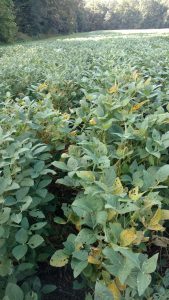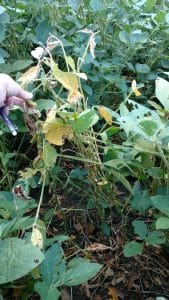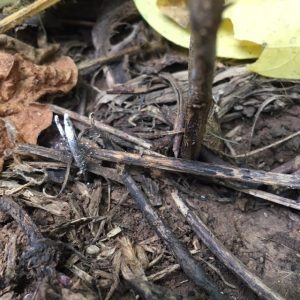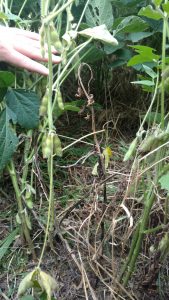Taproot decline (TRD) is a new disease to us in Tennessee and other states in the Southeast. A member of the genus (Xylaria) was first isolated from soybean in Ethiopia in the ‘70s , however researchers at that time did not confirm if this fungus was the pathogenic species that is now affecting soybeans across the southeastern US. The first report of taproot decline as a pathogen of soybean was published just last year, with sightings of this disease first occurring in 2007. Other states that have reported cases of TRD include Alabama, Mississippi, Louisiana, and Missouri with an increasingly northern range. A production field in Saulsbury (Hardeman County) was confirmed to have soybeans affected by TRD in August 2017, and two additional research fields in Gibson and Madison counties were confirmed in August 2018. Foliar symptoms were initially spotted at growth stage R6 (i.e. full seed); these foliar symptoms can easily be confused with those due to other diseases like sudden death syndrome and stem canker, and closer observation is needed for disease identification. Once initial foliar symptoms are observed (Images 1 and 2), additional steps need to be taken in order to accurately diagnose the disease. If you suspect TRD, follow these steps for diagnosis and contact your local county agent and/or Heather Kelly for confirmation:
- Check the ground surrounding the symptomatic plant(s) for reproductive structures called stromata (Image 3) that typically grow on last season’s debris: these are branching structures covered in white powdery spores. These could be present or absent on the ground at the base of diseased plants growing out of previous crop debris.
- Check around symptomatic plant(s) for plants that died prematurely (Image 4), which can be caused by TRD.
- Pull up the entire plant to view the root mass. Diseased plants will exhibit rotten roots, with the taproot usually breaking off below the soil line, root necrosis throughout the xylem, and the pith may be filled with white mycelium.
- If you suspect TRD in a soybean field, please send samples to the Plant Pathology Lab at the West Tennessee Research and Education Center (WTREC) for confirmation. We will continue to track the presence of this emerging disease in Tennessee.
Contact Heather Kelly, Plant Pathologist (UT), by email (youngkelly@utk.edu) or phone (731-425-4713) for further information. Samples may be sent to Plant Pathology Lab C, WTREC, 605 Airways Blvd., Jackson, TN 38301.





